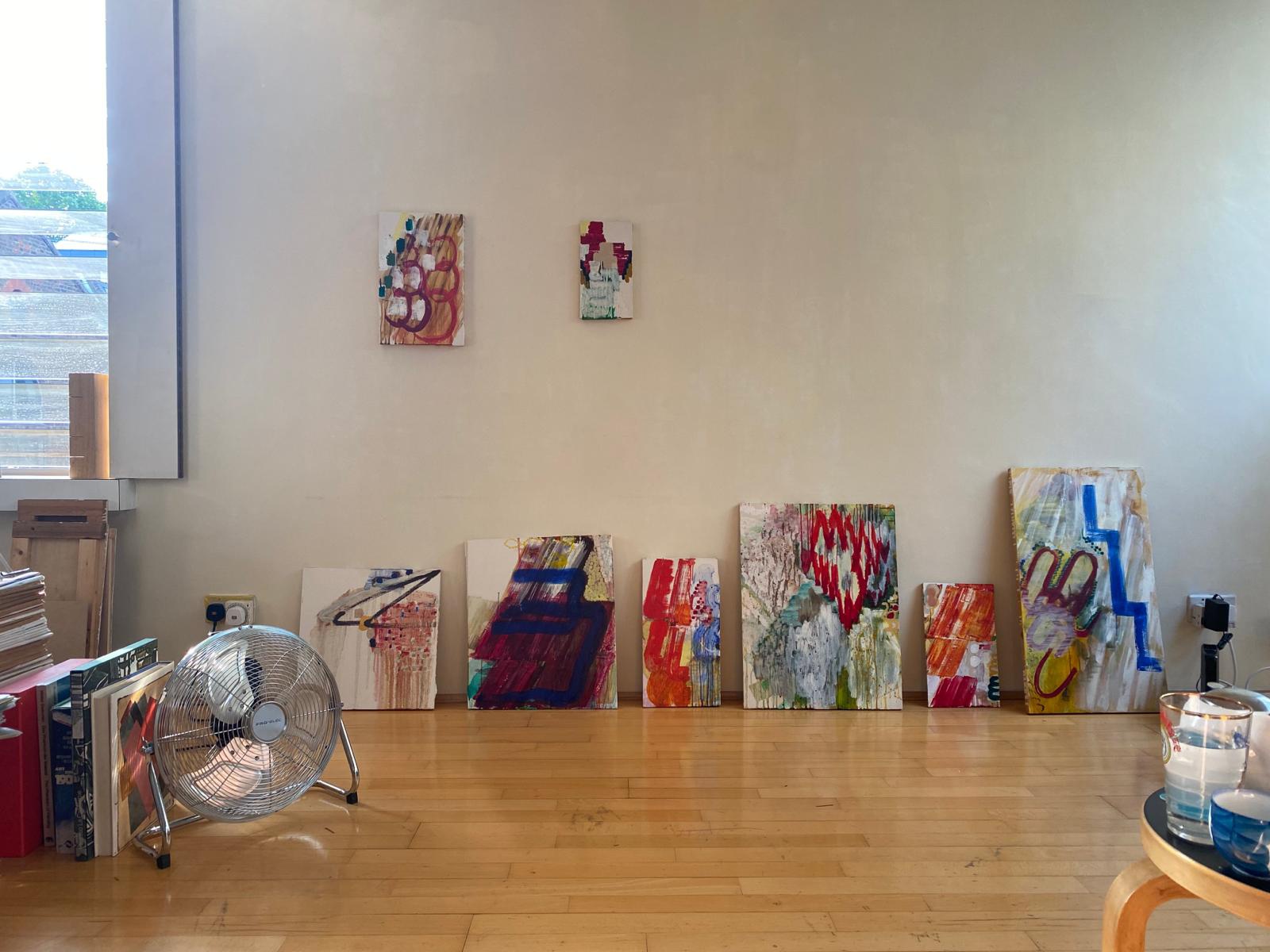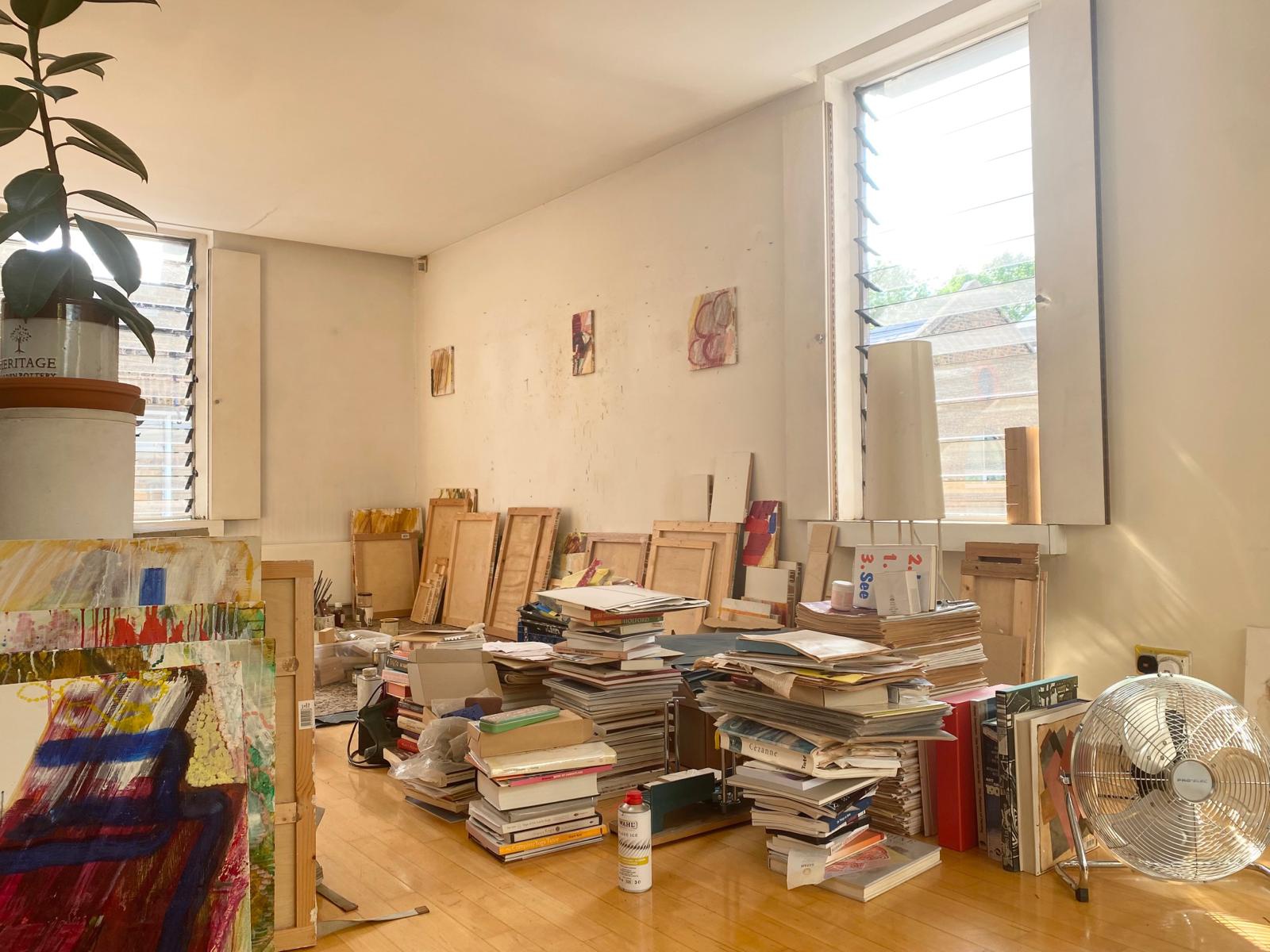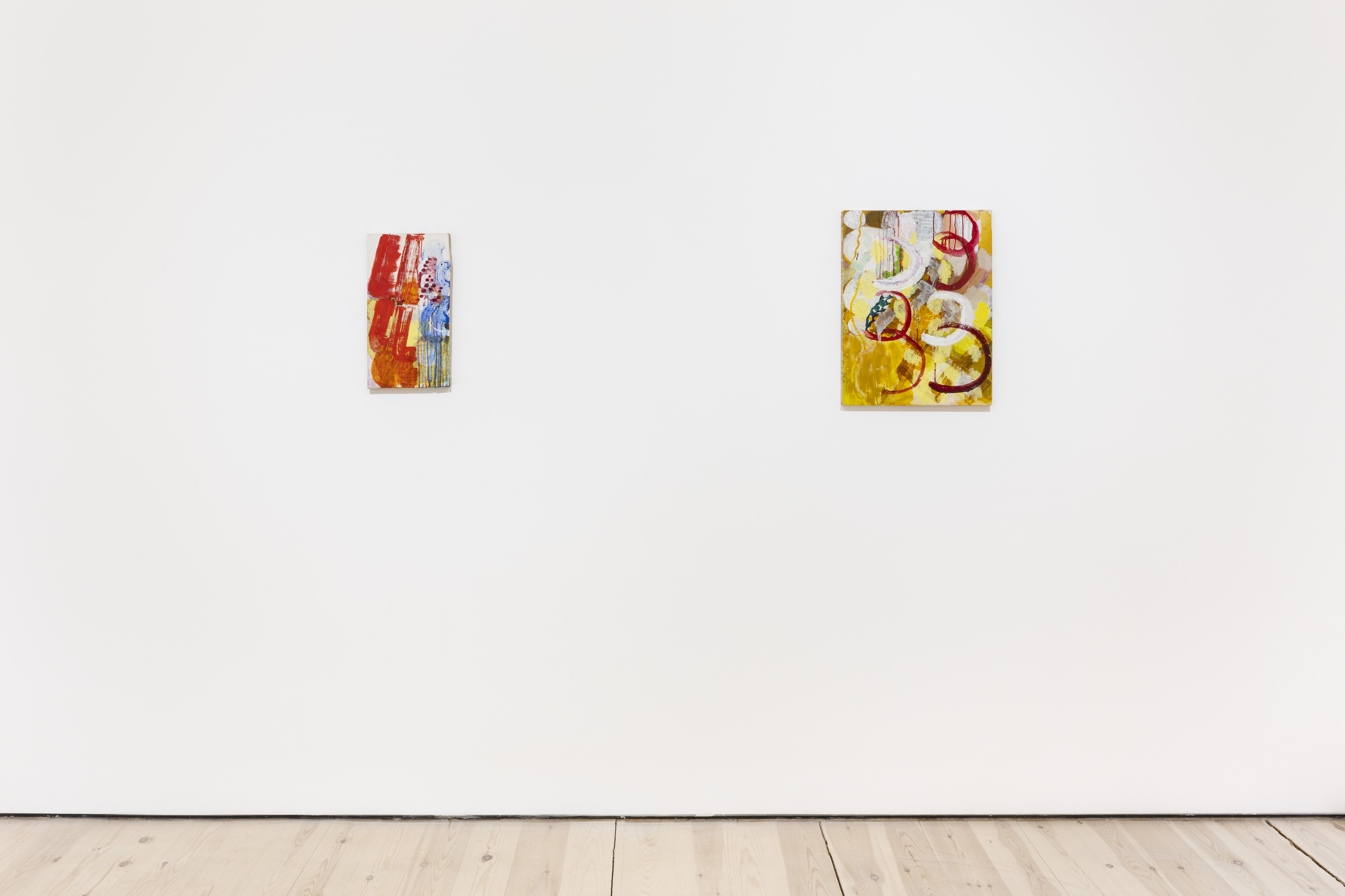
MAMOTH was honored to have Barry Schwabsky to write about Sherman Sam and his latest duo exhibition 'Duet' with Nancy Shaver (18th of January to the 29th of February 2024) . Barry went along to Sherman's studio in London to find out about Sherman's work and process.
Barry Schwabsky is a writer, critic and poet. He is the current editor-at-large for Brooklyn Rail and has written for various platforms including Artforum, London Review of Books and Art in America. He has written many books on such artists as Henri Matisse and Alex Katz and has taught at several universities: Goldsmiths College, New York University and Yale to name a few. He currently lives and works in New York, USA.
Sherman Sam (b.1966) is an artist and critic based in London and Singapore. As an artist, he has shown with various galleries and institutions such as the Centro de Arte, San Joao de Madeira, Portugal and the Rubicon Gallery in Dublin, Ireland. As a writer, he contributes regularly to platforms such as Artforum, Ocula and artcritical.com. In 2006-2008 he was the Inspire Curatorial Fellow at the Hayward Gallery in London and was the selector for the Pro Arts 2010 Juried Annual in Oakland, California.
Click here to find out more about the exhibition 'Duet' with Nancy Shaver and Sherman Sam, in the meantime - we hope you enjoy Barry's persepctive.
Sherman Sam's Patience
To say that Sherman Sam’s paintings are abstract is stating the obvious. But shouldn’t the things that are evident be discussed too? If not, they become what people call “the elephant in room.”
Besides, I tend to give a special meaning to the word “abstract.” But not always. Sometimes I use it in a general way, a “you know what I mean” way, where it really means “not figurative.” But then sometimes I say of a certain artist, “His work is really abstract.” What I mean is, essentially, that it tends to evade language: You can’t easily put a name to what’s in the painting. To give a couple of examples: I would not say, “His work is really abstract” about Josef Albers, because you can very easily communicate in words what his paintings show; they are paintings of squares. Or Agnes Martin: Hers are self-evidently of pencil-drawn grids or lines, tinted with pale washes of translucent color. Easy. Of course, their works have effects that go beyond anything that can be conveyed by their straightforward description, but the same is also true of works that are not called abstract: “It shows a woman holding a baby on her lap” (Giovanni Bellini); it shows some clothed men and a naked woman lounging in a lush landscape” (Edouard Manet)—and so on.
But there are other painters who make it very difficult to specify what their works show, or to say by what process they arrive at their results. They are the painters I tend to say make works that are really abstract. Among those who come to mind, for me, are Varda Caivano, Cora Cohen, Michaela Eichwald, Ida Ekblad, Rosy Keyser, and Charline von Heyl. I don’t want to speculate about why I think particularly of women artists in this regard. Does it mean that women are actually more drawn to pursuing this mode of artmaking or simply that I notice them more? I can’t say. But anyway there is at least one exception to this female dominance among those I think of as really abstract painters: Sherman Sam.

Sherman Sam, Studio View, London 2024 © Image Courtesy of Sherman Sam, London UK.
Wearing his art critic cap, Sam once wrote of Caivano’s work as “creating a fluid and shifting space held together by patches of color and paint, ‘pictures’ that question their own premise.” Can they, if they sufficiently question their premises, still be pictures? What do they show? I ask the same question of Sam’s paintings, and as a critic, I feel mortified at how tongue-tied I feel as I face that question. Of course, there’s always the formally reflexive gambit: “His paintings show nothing but themselves!” But that feels to me like a coward’s way out, because what are they themselves? If I were to characterize Sam’s works in the broadest sense, I would call them paintings full of thought. And one of the things that makes them hard to describe is that they are much more full of thoughts about form than they are full of things that can be encapsulated as forms. Yes, there may be little repeated marks that you might refer to by some silly name—I’ve heard Sam refer to some of them as elbows—or not very descriptive descriptions: drips, splatterings, and so on. I remember calling certain things in his paintings “steps” or “stairs.” These names mean nothing. In fact they are more like names (which tell nothing about their bearers) than they are like common nouns, names having little if any semantic content. Just because I say stairs, it doesn’t mean I think a nude could walk down them. Sam considers such associations to be random, but amusing. “But I try not to have eyeballs and noses in there,” he adds. “If I see them while I’m working on it, I’ll paint them out.” The thoughts that his paintings are filled with don’t congeal into objects.
Just as they are full of thought, the paintings are full of time, but the time that’s invested in the paintings is not labor time; it’s not a measurable deposit of matter or a countable accumulation of marks. Like thought, time is elusive, and Sam lets it stay that way. He doesn’t try to nail it down. He would rather catch the traces of its movement.

Sherman Sam, Studio View, London 2024 © Image Courtesy of Sherman Sam, London UK.
The paintings are made slowly, which you might guess from looking at them, but they do not involve strenuous effort, and that is absolutely evident. In fact, Sam’s work seems to consist mostly of waiting; his artistic super power is patience. He told me that the least time he has ever spent on one of his paintings is a year, but that he considers three to four years pretty quick. The paintings are dated with the year they were finished, not with the range of years from start to completion—the reason being, the artist says, “I can’t remember when I started them.” I asked, “What takes you so long?” What was long was the answer, and it’s worth transcribing here:
“What I say to people is, sometimes, when you’re a painter, the thing you have in your mind inhibits you seeing what your hand has just done,” the artist told me. “Very often, you think, ‘Oh, I need to paint this yellow line here. And the yellow line that you paint isn’t the yellow line in your mind. So it takes a while to see what you’ve done and the possibilities for what can follow.”
And he gave this example: “I have a painting in my studio that’s sat there, I think, for at least five or ten years, and I’ve only touched it about three times. I know which way up it is, and I think I must touch it one or two more times to complete it, but I have no idea what I want to paint on it. But one day I’ll painting something on another painting that will help me realize what I need to do on that painting.” He summed this way of working as “very slow ADHD.”
That last remark may give you a feeling for Sam’s dry, self-deprecating humor, but the remark has a serious point. Desiderius Erasmus, the Dutch Renaissance thinker and author of In Praise of Folly (1509), liked to use the ancient Latin tag festina lente—make haste slowly. Sometimes, if you drive, you find yourself in a traffic jam on the highway; because you want to get moving, you take the next exit and find yourself wandering aimless side roads that get you to your destination later than if you had stayed with the sluggish traffic along the direct route. Or just the opposite: You wanted to take the main road at all costs, but you’d have gained time by taking the local route. In either case, there was a way that going slowly would have saved you time.
I remember, too, a conversation I once had with Lois Dodd, a painter I greatly admire: I made some remark about how much patience it must take to produce one of her works, which are typically painted in a single day, but therefore, presumably, involving very long, possibly arduous stretches of intense concentration; I imagine such days passing very slowly, or all too fast, but never at a rate any clock would countenance. In this limitation of the work to a day, the contrast with Sam’s practice could not be more patent, but patience exercised over the course of a day impresses me as much as patience exercised over the course of years. I should point out, though, that in other ways (modest scale, contemplative affect, and above all what John Yau called, with reference to Dodd, an impulse “to formally explore the tensions and pressure points that exist between surface and depth, and to underscore the link between the work’s status as fixed object and the painting’s state of immanent change”) the two artists’ work have much in common.

Nancy Shaver, Sherman Sam 'Duet', exhibition view, MAMOTH, London, 2024 © Courtesy of the artists and MAMOTH, UK. Image by Damian Griffiths
Anyway, back to my remark about Dodd’s remarkable patience. Not at all, was Dodd’s immediate response: her work, she told me, was the product of great impatience. I mention this conversation here because for me, it was one of those light bulb over the head moments. This was when it dawned on me that patience and impatience are dialectically related. The fact that the one word is formed simply by adding to the other a prefix that signifies negation might suggest that the two must be antithetical, but that would not be exactly right. Rather, patience is a special way of living impatience. One can only exercise patience in the presence of one’s impatience; it is in relation to its own lack that patience reveals itself. It means reconciling yourself to getting there faster on a slow road.
Sam’s art involves this kind of patient impatience to a rare degree. And yet the paintings are unconcerned with somehow putting on display the amount of time that has been put into their making. Nor is the time line of “moves” he has made in painting them entirely evident: Although of course one can see that certain marks have been layered over others and have therefore necessarily been made after those others, there is no reason to imagine that two adjacent marks that appear to subsist on the same layer were made at the same time—the one on the left might belong to the same time frame as some buried archeological stratum nearby. If Sam’s is an art of time, it is also, in a way that is after all quite traditional, an art that hides its art: Its extended temporality is compressed, in our perception, into a near-simultaneity. But I should put the emphasis on near. One never sees these paintings all at once. Even their funky facture, their eschewal of the appearance of anything like dash, brio, or facility, is among the means by which they impede any quick take. It’s especially surprising given the works’ humble dimensions, but it takes time to see these paintings.
“How much time?”
Well, how much have you got? They can accommodate. I myself have a painting of Sam’s that’s dated 2006, and which I probably acquired about a couple of years after that. So let’s say the painting and I have been together around fifteen years. We’re still getting to know each other. Maybe it’s the changing light, but the half-buried passages sometimes seem to show themselves with an unaccountable clarity—and then the next time I look, I hardly notice they are there; they fade back, like thoughts one has had in a dream fading into the troubling feeling of having had a dream you can no longer quite recall , into a general chromatic texture.
And yet the general, in these paintings, is always so particular. You might notice, for instance, that large areas of color are rare in Sam’s paintings, or rather, that if there are such areas, they appear more as concatenations of marks, of touches of the same color, which never entirely sacrifice their specificity to the overall effect they combine to create.
This coming and going between presence and elusiveness gives the painting a quality I’m tempted to call hypnotic, but then that’s not exactly the right word, because nothing in the work imposes itself on one’s attention like a hypnotic force. What this quality I can’t quite name has in common with the hypnotic is that it rather muddles one’s sense of time as one looks at the painting. I sometimes realize that I’ve been spending more time with it than I’d realized. But then, when that happens, I begin to feel that I haven’t spent as much time with it as I’d like to. I’m too distractable.
But then, maybe it’s just as well that I don’t see the painting all at once, and see different things in it over time. Just as the unfinished paintings can wait in the studio with their imperturbable active receptivity encouraging the painter not to forget that there still remain some touches that sooner or later—and no problem if it’s later—must be made, so the ostensibly finished painting waits on the wall for the next approach of the viewer’s gaze, when the understanding of it will again shift. What I’m saying is that something like the painter’s ability to work patiently through his impatience, to make haste with all the slowness of which he is capable, must come to the work’s beholder as well. And where does one learn that capability for eager restraint if not from the paintings themselves? Like all first-rate art, Sam’s instils in you what’s needed to appreciate it.
